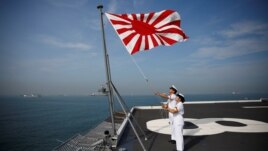11 October, 2018
South Korea's Jeju Island welcomed naval forces from over 10 countries at the start of a five-day international naval event. Yet painful memories of World War II appeared this week when Japan chose to stay away from the yearly exercise.
Japan is less than 1,000 kilometers away from Jeju Island. Japan said it would miss the event after South Korea asked Japan's Maritime Self-Defense Force not to fly its naval ensign, the 16-ray kyokujitsuki, or rising sun flag.
South Korea and other Asian countries strongly link the rising sun flag with Japan's aggression during the 20th Century. Some even go as far as to link the flag to war crimes and consider it a lasting symbol of World War II.

Sailors raise the Japanese naval ensign on the deck of Japanese helicopter carrier Kaga before its departure for naval drills in the Indian Ocean, near Jakarta Port, Indonesia September 22, 2018. (REUTERS/Kim Kyung-Hoon)
South Korea's navy had asked all nations taking part in the exercise to fly their national flags as well as the South Korean flag on their ships. Some observers saw that request as a way to prevent Japanese ships from flying the rising sun flag.
Japanese officials told the Associated Press that it is Japanese law for the country's naval ships to fly that flag. The officials added that only private ships fly the national flag, known as "hinomaru." This is done to differentiate between commercial and naval ships.
Japanese Chief of Staff Katsutoshi Kawano said the flag was an issue of pride for the Maritime Self-Defense Force sailors. He regretted the dispute with South Korea over its use. Japan rejects the idea that the naval ensign is a sign of war.
Flag Creates Deeply Rooted Emotions
South Korean Prime Minister Lee Nak-yeon noted his nation's opposition toward the flag earlier this month.
He said, "Japan must carefully consider the effect that the Rising Sun Flag has on the Korean people, who remember the pain of colonial rule."
The hostility toward the naval ensign is not limited to political issues. It also appears in South Korean popular culture.
In 2016, Korean singer Tiffany was removed from a television show because she used a rising sun flag emoji on Instagram. She posted the picture on August 15 to celebrate Liberation Day, the holiday marking Japan's World War II surrender.
Her use of the emoji immediately angered people. The television station announced Tiffany's removal three days later.
It is not just the flag itself that creates strong reactions. In some cases, a similar-looking design does, too. Earlier this year, Nike canceled the release of footwear covered with the design. In addition, the Hite Brewery Company discontinued similar markings on its beer products, even though the colors of its design were purple and blue.
Cho Young-sik is an industrial design professor at Ewha Womans University in Seoul. He said the rising sun design is "effective in getting public attention, with an intense color contrast of red and white."
Cho said the design's meaning differs from one culture to another. "Sunrise itself is generally considered positive," Cho said.
Cho also explained that the rising sun flag is more effective at communicating Japan's national identity than its national flag.
Renewed Push For a Legislative Ban
On October 1, South Korean legislator Shin Yong-hyeon proposed a bill in the National Assembly aiming to bar the use of the rising sun design in South Korea.
Shin's spokesperson said to South Koreans, the Rising Sun Flag is a sign of Japanese past military aggression. The spokesperson likened it to the Nazi party flag flown in Germany during World War II.
Japan defends its use of the flag, saying the unusual look of the rising sun has been used for hundreds of years.
Yang Gi-ho is a Japanese studies professor at Sungkonghoe University in Seoul. He says that, to the Japanese, the flag's design has an entirely different meaning than it does to Koreans.
He said he believes it is wrong to ban the flag in South Korea. But he also said Japanese officials should consider the feelings of South Koreans as both counties try to improve their relationship and move forward.
Steve Miller reported this story for VOANews. George Grow adapted his report for Learning English. Ashley Thompson was the editor.
We want to hear from you. Write to us in the Comments Section.
_____________________________________________________________
Words in This Story
ensign – n. a flag flown as a sign of nationality, normally with unusual markings added to its design
ray – n. a line of light coming from a bright object
symbol – n. something that suggests or represents something
pride – n. taking great satisfaction in one's self or ability
emoji – n. small images added in text messages or other electronic communications
commerical - adj. related to or used in the buying and selling of goods and services
positive – adj. sure; expressed clearly
utilization – n. the act of making use of something
concept – n. a thought or idea
motif – n. a single or repeated design or color